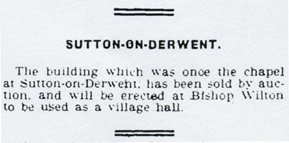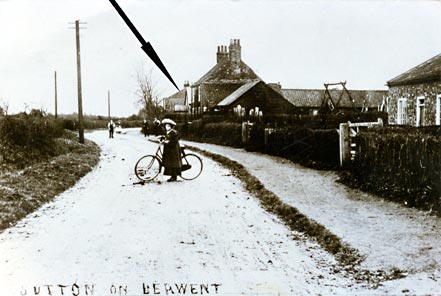
From Men's Institute to Village Hall
By Kate Pratt
previous article | up | next article
At a meeting one evening in Bishop Wilton Village Hall in April 2002, I started wondering about the fabric of the building, which is currently in a pretty poor state. I had heard the story of its former existence as a Methodist Chapel in another village, but when I enquired about it from the older residents of the village, no-one could quite remember the date it arrived, or where it had come from – I was given a choice of 3 different places, Gate Helmsley, Sutton-on-Derwent or Thornton. So I decided to try and do some research to discover the truth.
I knew that the Hall had been bought by the Men’s Institute, a social group which had been a thriving twin to the Women’s Institute, so I tracked down the books which were still in the possession of Harry Smith, who retired to Pocklington from Bishop Wilton a few years ago. The Men’s Institute was started in 1922, and although the Minute Book for 1923-53 was missing, I was able to find a reference in the Accounts Book which pinpointed the year of purchase of the Hall to 1937. So I went to the Reference Library in Beverley where one can read the local paper of the time – The Howdenshire Chronicle and Pocklington Weekly News – on microfiche. After much eye-aching scanning, I managed to find this little paragraph from the paper on Christmas Day 1937:

Now that I knew that the Hall came from Sutton-on-Derwent, my next visit was to the Local History Archive Library in Beverley, where I was able to view the documents relating to the building of the Primitive Methodist Chapel in 1882 at a cost of £202, and to its subsequent sale. Exciting stuff.
Next I visited Sutton-on-Derwent, and not really knowing who to ask, I called at the School, where the Head Teacher was most helpful, directing me to their (beautiful) Village Hall, whose walls are covered with old views of the village. Sadly none of them showed the Methodist Chapel. After talking to several people, I was put in touch with Mr James Beal, who I was assured was the best person to talk to, with a wonderful memory. I phoned him to arrange a visit, and spent a very interesting hour or so with him; he remembered the ‘tin tabernacle’ in use, and then its decline, and finally its being dismantled and taken away by Mr Sim Flint, on the back of a cattle wagon. I was really pleased to have tracked down an eye-witness – the wind was taken out of my sails a little when I learnt that Mr Beal is the father of Ann Rudsdale here in the village, who of course knew the whole story all the time….. Anyway, he showed me exactly where the chapel had been, in the garden of Wheelwright’s Cottage. The current owner was in her garden, and on being told of our interest, was able to produce an old photo which just shows the Chapel, or at least the entrance porch.

So the original part of the Hall, the Men’s Institute, was erected in 1938. It had taken the group 16 years to raise enough money to buy the building and pay for all the building and plumbing work involved – and the very next year it proved invaluable as a school for the children evacuated from Sunderland and later from Hull.
During the 1940s the Hall was in great demand, and in 1952 it was extended and modernised; as no extra land was available, the kitchen extension was built on an East-West axis, forming an L-shape. The total of £680 2s 8d owed to the builder J H Bailey took 7 years to pay off!
Finally, in 1972 the Men’s Institute folded, and the building became
the Village Hall, although it is still called by its former name by the
older generation.
(c) Copyright 2009 Contributors. All rights reserved. |